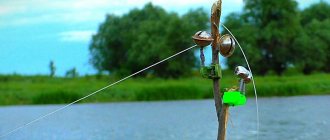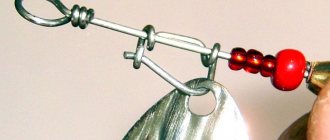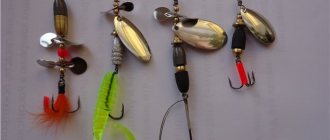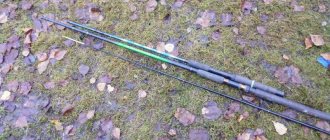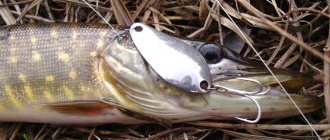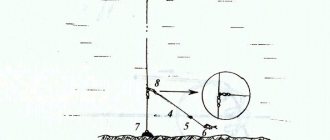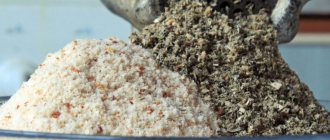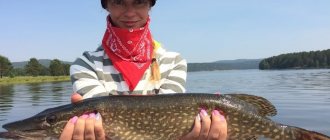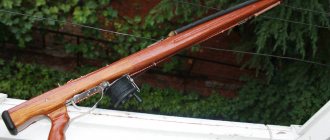Zherlitsa flyer
Any novice angler is able to catch a trophy pike or seasoned humpback perch with a flyer, which he is unlikely to succeed in mastering a spinning rod.
Moreover, some spinning baits are simply not affordable for a beginner. At least in the right quantity for successful fishing in different conditions and reservoirs.
Here you need to make a simple tackle, catch crucian carp in the pond and place the bait in a good place. She will do the rest herself...
This tackle has been known for its catchability and ease of fishing since Tsarist times.
Although the table of the eminent merchant and nobleman had enough salmon, sturgeon and the “Sheksna golden sterlet”, those others also loved the modest domestic pike, straight from the water, fresh and large.
And the pike head was one of the delicacies of that time: in aspic, served cold with horseradish, boiled with garlic.
The morals were simple and the gear was the same. The flier is one of those legendary tackles. Despite its simplicity, it was invented very rationally and cunningly.
The advantage of a self-catching girder
Catching pike with a self-catching rod, its main advantage is that it works with a self-catching rod, without the participation of a pike angler. This allows him to engage in fishing for the soul at this time: with a spinning rod, a fly rod, a feeder, etc.
Meanwhile, the simple bait catches fish, guaranteeing the fisherman a catch if he catches only a bunch of mud with his silicone bait.
The reason for the success of this tackle is that any predator always takes more actively on live fish. None of the most expensive baits can replace live bait.
Another thing is that in real heat, when the pike grabs everything, the spinning rod works faster and more efficiently at the place where the predator exits.
But even at the same time, the largest specimens of fish are still caught on live bait tackle.
Characteristics of the main types
Homemade fish traps can be of several types. They are:
- Stationary . These are hydraulic structures that are attached to the bottom and remain under water for a long period. The simplest version of a stationary trap is stakes with a net stretched between them.
- Mobile . Portable fishing lures can be divided into tunnel and screen lures.
Tunnel varieties can be made of metal mesh or woven rods. The essence of such a trap is that when a fish gets into it, it simply gets lost in the tunnel, so it cannot get out of it. The structure must be made so that the fish can easily swim into it, but not swim back out.
Screen traps are also called “spiders”. They are distinguished by their flat shape. Most often it is a net stretched between four rods, and a bait with a sinker is attached in the center.
The bait is also placed on top, so as soon as the fish gather near the bait, the net can be immediately raised.
The principle of fishing with a self-catching girder
And, of course, the principle of the girder - samolov - implies that there will be no one nearby, so there will be no noise, which means that the largest and most cautious fish can grab the bait.
The flyer was originally made from the fork of a willow tree or other shrub. When dried, the willow flyer was very strong and the strongest and most elastic fishing line wound around the flyer could not squeeze it.
Now there is no need to cut willow and plan out of it something like a slingshot - the weapon of boys of the 20th century. You can cut a flyer out of vinyl plastic and similar material.
It will be heavier and sway less in the wind, which often quickly kills the bait. In addition, from the smooth surface of the plastic and fishing line, the fish will be able to unwind without effort, which means that the pike will not get stuck on the hook ahead of time and will not get off.
On the finished flyer, without burrs on the forks, 8-10 m of thick fishing line 0.5-0.6 mm is wound in a figure of eight or crosswise manner.
An “olive” weight or equivalent in weight is attached to the fishing line. There is no point in placing it heavier, since the fishing takes place in grassy shallow waters.
A fastener with a swivel is attached to the fishing line, into which a rigid metal leash with a double or “Finnish” hook is fastened.
Techniques and tactics of fishing with a self-catching girder
- A thick fishing line is needed so that it doesn’t cut your hands when fishing for large fish. In addition, installing vents near aquatic vegetation ensures that the place is chosen correctly and the predator is here in ambush or hiding from the sun.
But the same guarantees can be given in the fact that after the bite the pike or perch will go into the grass to swallow the bait. And then the thin fishing line may not be able to withstand the tearing of prey through the thickets of egg capsules.
If you put the girders in a clean place, then the fish can only take them by passing by.
Moreover, if she takes it, she will most likely get off the hook, since there will be no elastic stems of the egg capsules, which act as a shock absorber during the jerks of the predator.
- The fishing line, when alert, becomes pinched in the cut of the fork. During the grab, the predator pulls it off and begins to unwind it. At the same time, the flyer begins to spin.
The figure-of-eight winding does not allow the flyer cord, which attaches it to the pole, to twist. The flyer simply rolls from side to side without rotating in a circle.
- A rigid metal leader is necessary for baiting bait by passing the leader through the gills. This method reduces the activity time of small fish used as live bait, but is the most reliable.
There are almost no gatherings. For this, a homemade double without beards is more suitable. It resembles sharply sharpened antennae, bent back.
This hook can be made at home using piano wire or spring steel wire.
Unlike factory counterparts, the “Finnish” hook does not have such a long fore-end and therefore is located in the mouth of the live bait, not reaching the gill covers and gills.
In the first case, the forend quickly destroys the live bait. Using purchased doubles, it is better to hook live bait under the dorsal fin.
And for greater reliability, you can add a short leash with a single hook, hooking it on the lip of the baitfish. It should be noted that the Finnish hook is intended for catching pike.
Large perch also catch it, but there are more catches than pike. A factory twin will do here.
Stationary and unusual designs
It is recommended to catch large specimens using stationary structures. The simplest option is a mesh box. The frame can be made of wooden boards or plastic slats. You can also take two hoops for the waist, so you get a round-shaped trap.
After the frame is prepared, you need to create fastenings. It should be borne in mind that the box must be disassembled in order to get the catch out of it. The walls need to be lined with plastic mesh. To do this, you can take a simple garden net with 1 cm cells or a Chinese nylon net.
The most difficult stage is creating the entrances that will resemble a funnel. They will need to be placed on different sides of the box. The advantage of this design is that it is easy to transport and is suitable for catching fairly large specimens. You can put a jar of fry inside as bait. This type of structure is great for winter fishing.
Another option for traps is a fish catching screen. You can do it with your own hands quite quickly. This will require thick wire and mesh. Two pieces of wire will hold the net in the water in a standing position to form a kind of screen where the fish will float up. You need to place a feeder in the center; it is important that the bait is washed out of it gradually. It is recommended to lower this structure to a depth of about 2 meters.
Bait for self-catching girder
And now another important point. The finished flyer must be hung from a pole in the chosen place, and then baited with small fish, preferably crucian carp for the summer, since crucian carp is incredibly tenacious.
And although pikes don’t always like it, they nevertheless take it for crucian carp almost everywhere. Even if roach is a more familiar and attractive prey for pike and perch, these fish will last much less on a hook than crucian carp.
The pole is placed at an angle of 45 degrees, and with a very long pole the angle can be made even sharper. This will ensure that the bait will not get caught on the pole.
You can stick it directly into the grass, and the live bait will then be located along the edge of the vegetation, without touching it and without being able to hide in it from the sharp-eyed pike.
The most successful places for installing flyer vents are windows or long gaps among egg pods or dense thickets of hornwort.
Strips of grass along the shoreline are also catchy, even if it is shallow. And the largest pike goes out in the mornings and evenings into the grassy pools near the shore, where the water boils from the melting small fish.
Source: www.ulovanet.ru
Characteristics of the main types
Homemade fish traps can be of several types. They are:
- Stationary . These are hydraulic structures that are attached to the bottom and remain under water for a long period. The simplest version of a stationary trap is stakes with a net stretched between them.
- Mobile . Portable fishing lures can be divided into tunnel and screen lures.
Tunnel varieties can be made of metal mesh or woven rods. The essence of such a trap is that when a fish gets into it, it simply gets lost in the tunnel, so it cannot get out of it. The structure must be made so that the fish can easily swim into it, but not swim back out.
Screen traps are also called “spiders”. They are distinguished by their flat shape. Most often it is a net stretched between four rods, and a bait with a sinker is attached in the center.
The bait is also placed on top, so as soon as the fish gather near the bait, the net can be immediately raised.
Slingshots
Slingshot fishing is one of the easiest ways to catch pike, but at the same time it is the most catchy! A slingshot is a slingshot with a fishing line wound around it. It is worth noting that the fishing line is wound around the slingshot in the form of a figure eight, and a notch is made at one of the ends of the slingshot, which should fix the fishing line and prevent it from unwinding. It is best to wind not fishing line, but nylon thread. As a slingshot, you can use a piece of rubber hose or a plastic water pipe with a diameter of 25 millimeters.
A plastic pipe is better suited, the trap turns out to be light, does not sink, and the nylon thread in the slot holds firmly, the live bait will not be able to unwind the trap.
A piece of hose must be made, on one side, two opposite holes, and on the other, a slot for fixing the nylon thread before the bite. Next, we thread the nylon thread into 2 holes at one end of the hose, make a loop (with the help of this loop the trap is attached to the pole) and wind 5-6 meters of nylon thread with a diameter of 1 mm onto a piece of rubber hose. At the end of the nylon thread we tie a metal leash equipped with a double hook, onto which the live bait will be attached. As a leash, you can use a leash material; it is a multi-strand, flexible metal wire of different thicknesses designed for 12, 15, 20, 30 kilograms and a length of 10 meters. It is necessary to cut off the required piece of the leader material and make a non-tightening loop at both ends; on one side, tie the nylon thread to the other; the double hook must simply be threaded into the loop. To place live bait on a hook, you need to carefully pass the leash through the gills, then insert a double hook into the loop of the leash. The pole on which the trap is attached is placed at an angle of 45 degrees, and with a very long pole the angle can be made even sharper. This will ensure that the bait will not get caught on the pole. You can stick it directly into the grass, and the live bait will then be located along the edge of the vegetation, without touching it and without being able to hide in it from the sharp-eyed pike. Some good places to install flyer vents include windows or long gaps among egg pods or dense thickets of hornwort. Strips of grass along the shoreline are also catchy, even if it is shallow. And the largest pike goes out in the mornings and evenings into the grassy pools near the shore, where small fish swim. These slingshots can be used in winter. The principle of winter gear is this: all the gear was lowered into a hole under the ice, and only the twine and loop remained on the surface. A stick was inserted into the loop, which in turn lay across the hole, firmly fixing the tackle. It is necessary to lower the tackle under water, since otherwise an edge of ice will form in the hole and then the fishing line will stop reeling off the slingshot. In winter, live bait must be lowered 2 meters from the ice surface or suspended above the bottom a meter or two.
Watch the video How to make a trap
Watch the video How to use leader material
All-season trap
A universal all-season self-trap for pike is made with your own hands as follows:
- A piece 100 mm long is cut from a polyethylene pipe with a diameter of 25 mm.
- The cut is processed with a file and sandpaper.
- Two through cuts with a depth of 7-8 mm are made in the walls of the ends of the tube, located crosswise relative to each other.
- At the end of the cuts (made with a hacksaw blade in the pipe wall of through grooves) of one cut, two holes are made with a 6 mm drill, and sharp corners and edges at the entrance of the cuts are cut off with a sharp knife.
- Then, 20-30 mm are retreated from the edge where the manipulations described above were performed and one hole is made with a drill with a diameter of 2 mm.
- On the opposite edge, crosswise to the cut made in the end of the pipe, two semicircular recesses are made using a round file.
- A strip of bright red self-adhesive film 50-55 mm wide is glued to the middle part of the tube.
- The end of the cord is passed into the single hole made, and a loop 150-200 mm long is made on it.
- The cord passed through the hole is secured with another double knot.
- A nylon cord is wound around the middle part of the pipe.
- A sliding sinker is placed on the end of the cord, a swivel with a carabiner is tied, to which a metal leash 150-200 mm long is fastened.
- A rubber band cut from a bicycle inner tube is threaded into the cut with holes.
In order to charge such a plane, they unwind the required amount of cord, place it on the live bait double, tighten the elastic band and fix it in the semicircular recesses at the opposite end of the tube. When biting, the elastic band slides out of the semicircular grooves and the pike that has swallowed the bait freely unwinds the entire cord from the tube.
Victoria Leshchenko
I've been working hard in the fishing tackle department for the past six years. I can help you assemble almost any gear.
Ask a Question
In winter, the loop at the end of the cord is placed on a long stick, after which the tackle is lowered into the hole. Due to this location, some fishermen call such a vent under the ice (underwater).
In the summer, samolov, like all other girders, are hooked to a long stake or branches of bushes or trees.
How to make a reliable and simple self-trap for pike is described in the video:
Samolov mugs
Circles are the name given to tackle that drifts freely through the water. It is made mainly from wood, foam, plastic or cork. This kind of tackle looks like a circle, but it is made in this shape only to make it more difficult for the fish to drown it and for the fishing line to come off smoothly when biting. For the most part, this tackle is used in still water or on water with a weak current. If we talk about the sizes of the circles, then their diameter is 140 - 180 mm, and the thickness reaches 30 mm. There is a special recess in the circle for winding fishing line. In the very center of the disk, make a hole with a diameter of 10-12 mm. specifically for the mast, the length of which is 140-150 mm. At the end of the mast, a slot is made, the purpose of which is to bite the fishing line on which the bait is located. Having unwinded the required amount of fishing line so that the baitfish could swim freely and not wrap the cord around the snag, we insert the fishing line into the slot, thereby loading the bait and lower it into free swimming.
One hundred manufacturers, and simply the fishermen themselves, supply the second end of the mast with a ball or boss. And the surfaces of the circles are painted in different colors. This is done for ease of monitoring bites. When hooking a pike, the circle flips over to the other side and the line begins to slide off smoothly, preventing the fish from suspecting something is wrong.
Watch the video Installing circles on Pike
Watch the video Autumn fishing for mugs
When catching pike with fly fishing rods, the live bait must be alive. Pike is ready to attack any bait, but there must be no putrid odor.
The influence of weather on pike fishing
The peak of feeding activity (zhora) of pike occurs as soon as the atmospheric pressure begins to decrease (usually the wind begins to blow, before cloudy weather). If there is a sharp decrease in atmospheric pressure as a result of a cyclone with thunderstorm fronts, you are guaranteed an excellent catch and a crazy bite during this period of time.
If after the rain the weather begins to improve, the pressure begins to stabilize or increase, the activity of the pike will begin to fall or stop altogether. If the pressure continues to drop, the pike will not stop biting. One has only to take into account that the toothy one may be in places deeper than usual. Stage of increasing atmospheric pressure. This is a complete refusal of food by the predator. In this state, even a hungry pike can stand in a school of small fish all day and not touch anyone. The small fish take advantage of periods when the pike is indifferent to it and begins to actively feed.
Great catch
Rybachok Artyom
Rybachka Galina Petrovna
Watch the video “Catching pike with a trap”
Download video “Catching pike with a trap”
Watch the video on You Tube
Description of pike
Pike is considered the most predatory freshwater fish. Its appearance clearly demonstrates this: this fish has a long, flattened head, a huge mouth with many small and large teeth. The victim, having fallen into the mouth of a pike, can no longer escape, since its teeth are pointed towards the throat. The color of this fish depends on many factors: age, nutrition and the type of vegetation in its habitat. In reservoirs, pike usually stay in thickets and under snags. There she waits motionless, hiding, then suddenly rushes at her prey. The caught prey is swallowed only in the direction from the head - if the pike grabs the fish across the body, then before swallowing it quickly turns the prey with its head into the throat. Pike meat contains many useful vitamins and microelements. It is beneficial for the health of the skin and mucous membranes, nervous and digestive systems, regulates blood sugar, and is an antioxidant. Pike meat is useful for thyroid disease. This fish contains a lot of phosphorus and potassium, it also contains magnesium, calcium, sulfur, sodium, zinc, iodine, iron, copper, chromium, fluorine, manganese, nickel, cobalt, molybdenum (pike generally holds the record for cobalt content). As for vitamins, pike meat is rich in such types as A, B1, B2, B6, B9, C, E, PP. Dietary pike meat compares favorably not only with the “red” meat of artiodactyl animals, but also with the dietary meat of chickens and rabbits. After all, it contains a minimum of fat (about 1%) and a lot of useful substances, which include a fair amount of unsaturated fatty acids.
Source: alekc571.narod.ru
Places for installation of the supply
In coastal areas there are a lot of predators, for which there are many natural shelters in grass or snags. These are the places that pike prefer to occupy. In addition to the opportunity to hide in ambush for the toothy predator, there is a rich food supply near the shore in the form of large schools of small fish. Let's look at several promising points where the chances of catching a pike are high.
- The gear can be installed in a grassy bay surrounded by reed thickets. It is enough to watch the surface of the water a little from afar to see many predator exits.
- A lot of pike are hiding in snags, reeds, and under fallen trees.
- Good points for installing supplies will be channels where a strong current is adjacent to standing water.
- Promising places will be sand spits below the islands, straits between the islands and any other anomalous coastal areas.
Near the shore, in places littered with branches, there are a lot of pike. But how to catch a predator without tangling the tackle? To do this, it is better to use a supply with a fixed supply of fishing line. Then, after the bite, the toothy one will not have the opportunity to go into the deep snags. In such places it is better to use bleak as live bait. It will not strive for depth, but will float above the snag. The casting of the equipment is done through the window between the snags.
A bunch of reeds can be used as a shock absorber. It is enough to tie the fishing line of an abandoned tackle to several closely spaced plants to prevent the leash from being cut when a predator attacks.
If the choice of place to install the supplies is made correctly, then the first bites can occur within the first 10-15 minutes. Despite the small size of the predator, fishing with traditional girders will be a very interesting activity. So the fisherman will not be bored. Large perch and pike perch may be bycatch.
Specifics of winter bait fishing
Fishing with flags is not just about placing poles under the ice and waiting for a bite. To catch a predator consistently and reliably requires a deeper approach. It is important for the fisherman to get to the right place at the right time, use working gear and equipment, find fish or wait for a predator to come out, offer the right bait, be able to hook and pull the prey onto the ice. Each of these points has its own characteristics. The success of fishing with girders in winter, in addition to equipment, personal skill and the fishing tactics used, is strongly influenced by external factors:
- The level of activity and location of the predator depending on the winter period, oxygen content in the water and migrations of forage fish.
- Daily activity of fish.
- Influence of weather and moon phases.
Season
During the first ice, the entire predator is active. The water is still warm, the food fish are staying close to the shore, and all the underwater inhabitants are filling their bellies, creating a supply of nutrients for the winter. In some species of predator, a real glutton may be observed on the first ice. At this time, it is better to use larger live bait, in the hope of a trophy specimen. The best tactic is active search. If you know the time of the predator’s exits, then you need to arrive at the reservoir in advance in order to have time to expose yourself. In December, predatory fish are active; if there are no flags at one point for a long time, it is better to move the gear to another place.
With the onset of deep winter, life in the reservoir freezes, the temperature decreases, and the oxygen level drops. The fish move to deeper places, including small fish. The pits are simply warmer and there is more oxygen. A predator follows the forage fish. In January and February, the main thing is to search for a predator. The fisherman needs to accurately find the parking spots. During this period, fish are passive, do not go far to hunt, and do not eat much. During the entire fishing trip, there may be only one way out and simultaneous operation on all gear. This moment cannot be missed, nor can you make a mistake with the location of the flags. Small live bait is preferable, not too lively. A large predator, during periods of maximum passivity, sometimes takes better on a dead fish or a sluggishly moving one - it saves strength and energy.
Closer to spring, in March, the fish become more active. The illumination increases, melt water gets under the ice. The predator feeds more and more actively, moves further and further from its wintering grounds to hunt, and gradually returns to shallower areas in coastal zones and exits from pits. In large bodies of water, predatory fish move far upstream - their spawning migration begins. The search area is expanding significantly - and this is the main problem. In March and April, you can find fish in the upper reaches of the reservoir, at the confluence of tributaries, in the coastal zone (pike perch still follows deeper paths, coming out to the shallows to feed at night). If everything goes well in the spring, you can get caught by a predator on the last ice.
Times of Day
During periods of gluttony, the predator can feed at any time, depending on the body of water. The rest of the time you need to go fishing early and arrive at the reservoir in the dark. Sometimes the bite is a short outing with the first rays of the sun, in other bodies of water - when it is in full bloom, before lunch. Sometimes the predator is caught evenly throughout the day. The best fishing periods are morning, evening and daytime, from about 11 a.m. to 2 p.m. You need to catch perch in the light, and pike perch at night. Pike can catch in the dark, but still the best time is morning and before lunch. It all depends on the characteristics of the reservoir. Each of them has its own schedule, which can only be learned in practice or from the lips of local fishermen.
Weather and water conditions
The weather also affects the bite. Actually, atmospheric pressure itself has almost no effect on the activity of fish. However, a sudden change in weather disrupts the usual feeding rhythms of underwater inhabitants. Therefore, it is better to choose a period of stable weather for several days for fishing. The generally accepted opinion is that the bite is better in warm weather with a southerly wind, but this does not always happen. The predator can take it in both frost and snowstorm - it all depends on the specifics of the place. In the dead of winter, the promising time is long thaws. During such periods, all underwater inhabitants are more active. The phases of the moon have a greater influence on the pike's bite.
When fishing numerous times on the same body of water, you should keep a diary and record the dependence of the bite on weather conditions. This forecast will work, but only in this specific location.
How many fishing rods are allowed for winter fishing?
In our country, during winter fishing it is allowed to use either 5 or 10 fishing rods (one hook, double or tee) for each angler. This information can be clarified in the fishing regulations for the relevant fishing basin. In some rules you may not find the word “girder”, but then it will be written there that it is allowed to fish with all modifications of fishing rods with a total number of hooks (usually 10) or something like that.
Additional accessories
Before you set up a pike and send it into the water, you need to stock up on several important devices and tools. Even a small predator can swallow live bait deeply, and removing the hook will take a lot of precious time. The danger also lies in the sharp teeth of pikes. Cuts that remain on the hand can bother the angler for a long time.
- A yawner can be purchased at a store or made from thick wire. The jaws of the yawn close, after which the device easily penetrates the closed mouth of the pike. All that remains is to release the gaper so that the fish opens its mouth under the action of the spring.
- All that remains is to take an extractor or a surgical clamp to remove the hook from the pike’s mouth.
- It is more convenient to remove large prey from the water with the help of a capacious landing net.
- To save a caught predator, you need to take fishing rods or wire with a rope.
You can make a set right on the shore of a reservoir, when you manage to catch a few small fish. By choosing the right place for installation, you can hope for a pike bite. This method of fishing will bring a lot of pleasant emotions to any angler.
Source: fishelovka.com
Instructions for making a homemade zherlitsa
Catching pike with girders in winter is a very exciting activity, no matter what “advanced” fishermen say about its unsportsmanlike nature. But making such gear with your own hands is no less interesting and creative process. In this article we will give several examples of creating such a live bait fishing rod.
Homemade options
Today we present several models for your consideration. Homemade girders of these designs will not require you to purchase any special materials or products.
Here are some homemade winter girders for pike fishing we will look at in our master class:
- A shapeshifter made from a plastic tube.
- A container made from a plastic bottle.
- Subglacial vent.
- Vest on a leg.
- Priest on the platform.
Of course, to consider all the currently existing options for the format of a fishing article on the site is not enough; you will need to publish a thick book. But these five examples are enough for creativity, because we will describe only the basic options, and each fisherman can add his own twist to the design.
Changeling
To make such a girder for pike we will need:
- a plastic tube forty centimeters long;
- thick wire;
- bright electrical tape.
You see how little materials are needed for such a model, and making such a fishing rod is as easy as shelling pears:
- In the middle of the tube we drill a couple of through holes; their diameter should be equal to the thickness of the wire. We place the holes at an angle of ninety degrees.
- We insert the wire into these holes, it turns out that the tube stands on legs.
- At the front end of the tube we make a slot for clamping the fishing line.
- We wind the fishing line with the equipment on the front part of the tube.
- We wrap the back part with bright yellow or red electrical tape.
This girder works like this:
- We measure out the required amount of fishing line and clamp it in the cut.
- We equip the hook with live bait and release it under water.
- We install the structure with the front end above the hole.
- When biting, the pike pulls the fishing line, and the bait turns over with its front end directly into the hole, resting on the wire legs.
- The bright rear end of the tube is a great indicator of the bite.
This girder works best in mild frost and little snow.
From a plastic bottle
Of course, no Kulibin nowadays can do without an irreplaceable plastic bottle. It was also useful for making a winter fishing rod for pike. In addition to the bottle itself, we will also need a piece of cord, an elastic band for money and a stick cut off on the shore. The manufacturing process is simple, like everything ingenious:
- In the bottom of the “one and a half” we make a couple of holes into which we thread the lace.
- We attach this cord to a stick, which we freeze over the hole.
- We wind a fishing line with equipment on the side of the bottle.
- We measure out the fishing line, equip the tackle with live bait and lower it under the ice.
- We put an elastic band on the neck and fix a fishing line loop under it.
When bitten, the loop will pop out from under the elastic band and the line will begin to come off the bottle, swinging and unwinding it. This will be a signal of a bite.
Subglacial
Such girders for pike fishing are used when setting up at night or in particularly severe frosts. The entire “mechanism” in these structures is placed under water, and on the ice there is only a stick to which such a fishing rod is tied.
Under-ice girders are made from a hose, tubes, wooden flyers, softly thick wire, pieces of plastic or foam. And here is a schematic diagram of these structures:
- in the upper part a hole is made for the cord, with which the tackle is attached to a stick on the ice;
- a fishing line with equipment is wound around the body;
- a slot is made in the lower part to fix the fishing line, or a rubber band is put on.
In order to better see the bite in the hole, the upper end of such a girder is equipped with a multi-colored float, which, when rotating, shows the bite.
On a leg
This do-it-yourself vent requires more work in manufacturing, and a lot of materials are used, compared to previous models:
- plastic tube;
- checkbox;
- metal plate;
- fishing line reel;
- hose sleeve;
- bolts with washers and nuts;
- base.
Despite the large number of elements, it is not difficult to make this gear at home:
- We cut out the base from a piece of wooden board or hard, dense plastic.
- We make a hole in it to mount the tube.
- We make a slot for passing the fishing line.
- We fix the tube at the base.
- We cut out a spool holder from a sheet of metal.
- We bend one end of the resulting plate around the stand tube and fix it with bolts.
- We attach a reel for the girder to the free end of the plate; to do this, we cut out a sleeve from a hose of a suitable diameter and insert it into the hole in the reel.
- At the top of the tube we attach a flag.
You can first secure the flag in the cork, and then insert the cork into the stand tube from above. It is also possible to attach the shaft to a silicone tube pre-wrapped with electrical tape.
This perch can be used without a base by inserting the leg into the slush and freezing it. This will save space in your bag, but will not protect the hole from light and frost.
Pike baits
Pike on a girder in winter
There are two types of winter girders for pike:
- Classic over-ice girder for pike;
- Subglacial vent or postavusha.
Each type of vent has a huge number of design variations.
A classic over-ice pole for pike for winter fishing, consists of a pole rig and its holder along with a bite alarm in the form of a flag. That is why, when I catch pike on girders in winter, it is sometimes called fishing on flags. It is this type of girders that we will talk more about.
An under-ice vent (supply), as the name suggests, is installed under the ice. Most often, this type of vents is used for covert installation to avoid detection by strangers. Fishing with such girders follows the principle: set it up at night and check it the next day. An exclusively passive fishing method, more often used for catching burbot than pike.
Gear equipment
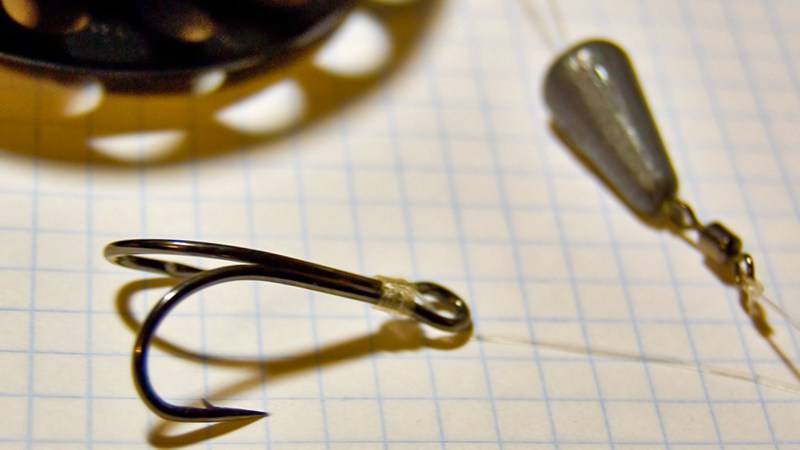
Regardless of the design, the equipment of the pike girder is mounted in the same way.
- Main line with a diameter of 0.3 – 0.4 mm;
- Sliding sinker "olive";
- A leader made of leader material, fluorocarbon or thicker line, or a flexible metal leader;
- Sharp treble, double or single hook.
For catching pike, a double hook (double) is most often used.
The length of the pike leash (the distance from the weight to the hook) depends on the depth and ranges from 0.5 to 1 meter (the deeper, the longer). The length can be adjusted by moving the load along the line.
The sinker must be capable of holding the baitfish at the desired horizon (weight depends on the size of the baitfish, depth and current). In shallow water (up to 1 meter) you can do without a load at all.
Installation of girder equipment for pike:
The device of the over-ice vent
The operating principle of the winter girder is based on the activation of a flag when a pike bites. In addition, the trap must provide the pike with free movement after the bait is grabbed, since it does not swallow it immediately.
A winter pike rig installed on ice consists of the following elements:
- Equipment;
- Gear stand;
- Reel (line holder) with a supply of fishing line;
- Bite alarm (flag).
The most primitive fishing rod can be considered a rig on a wooden fly, a flexible twig with a slot for fishing line and a red flag at its tip. When biting, the fishing line is pulled off the twig and it flies up, leaving a supply of fishing line on the ice for the pike to select. The blade is securely attached to the ice.
However, there are more advanced, convenient and at the same time simple designs.
The pole stand, the reel or line holder and the flag are the basis of the pole, which is one device that serves to interact with the pole equipment. The base of the girder is installed on the ice and can be designed as:
- Platform-cover for the hole;
- Tripod;
- Stand for installation in ice;
- Changeling or “cross”.
Vent on the platform-cover
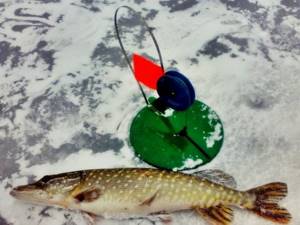
The vent on the lid covers the hole, thereby slowing down the process of formation of an ice film. This is the most common type of girders. The device is a structure that includes the following elements:
- A flat platform-cover, most often in the form of a circle, with a slot for the fishing line;
- Vertical removable stand with a reel for equipment attached to it;
- A flag on a spring plate fixed in the platform.
After installing the girder, the flag is loaded into the coil by the stop. When there is a bite and the reel rotates, it is released and triggered - it straightens, signaling that the pike has taken a bite (it shoots).
Zherlitsa on legs (tripod)

A pier on legs, most often on three (tripod) is installed above the hole. This is a fairly simple and common design that includes:
- Folding support on legs;
- Reel for fishing line for jig rigs;
- Bite alarm - flag.
Zherlitsa on the counter
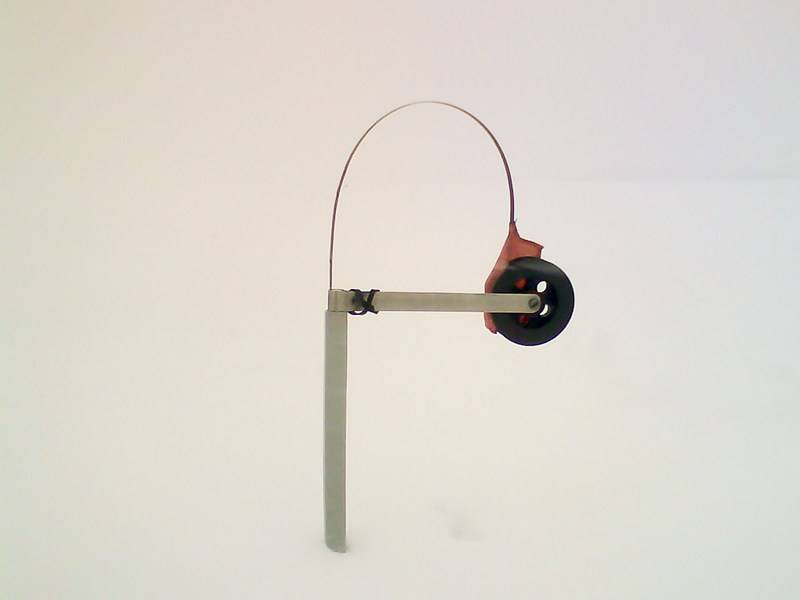
This is the simplest design. All elements of such a girder are fixed to a single stand, which serves as a support and is installed by freezing into ice or ice chips formed after drilling the hole.
Changeling priest or “cross”
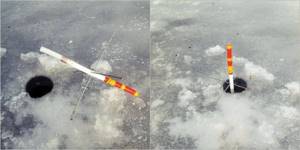
The design of the shifter's vent is a tube that serves to store a supply of fishing line and is also a bite alarm. A removable cross made of metal rods is built into the tube. The fishing line of the girder equipment is wound directly onto one of the ends of the tube.
Zherlitsa “Cross” or “Shifter”
When a pike grabs a live bait, the changeling dives halfway into the hole, signaling a bite with the other end. The line is released freely, giving the pike free movement. The cross serves to install the shifter on the ice in its working position, and after a bite, it prevents the pike from dragging the entire structure under the ice.
According to a similar principle, but without plunging into the water, girders work on a platform with an overturning “flag”, which is also a reel.
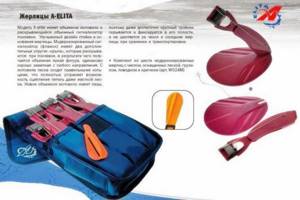
Under-ice design (delivery, self-trap)
An under-ice girder (flagless girder, set-up, self-trap) is completely immersed in the water, fixed in the hole with the help of a bar or pole having a length greater than the diameter of the hole.
The most primitive design of an under-ice vent does not have a line-dropping device. It is tightly attached to the bar, and a small supply of fishing line, sprinkled with snow, is located on the ice.
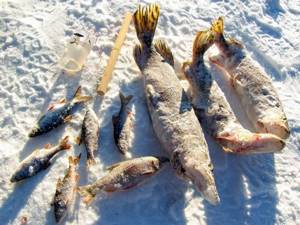
Pike on a fishing pole
A more complex design of an under-ice fishing rod for pike has a device with a reserve of fishing line for the pike to move after the bait is caught. This is either a reel or a line holder capable of freely throwing off the fishing line.
Anglers have an ambiguous attitude towards flagless samolovkas. Many consider this method of catching a predator barbaric, extremely unsportsmanlike and unacceptable.
It should be noted that there are under-ice designs of vents with flags, but they are inconvenient and rarely used.
Other designs
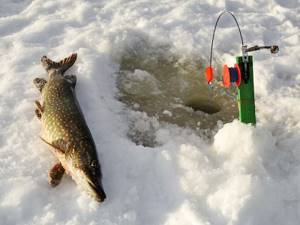
In addition to the described designs of vents, there are many others that are modernization or independent design solutions. They may have fundamental differences in the methods of fastening the elements of the girder or a special design of the bite alarm, but in general, this does not matter much.
Do-it-yourself zherlitsa
Due to the simplicity of the design of the zherlitsa, lovers of homemade products make their own zherlitsa from scrap materials. Different designs of vents have different manufacturing complexity, but even the most complex ones can be made independently.
How to make a girder for a pike:

